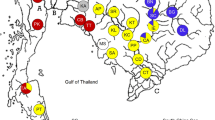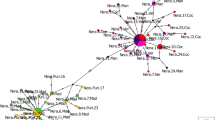Abstract
Sequence variation of the mtDNA D-loop region was analyzed in order to investigate the intraspecific evolution and the population genetic structure of the critically endangered European eel Anguilla anguilla. An additional attempt was made to collect information on the genetic characteristics of groups of eels representing naturally recruited eels to Lithuania and Latvia and introduced into Lithuanian lakes. A total of 148 eels were investigated, and 107 different haplotypes attributed to 39 haplogroups were determined during the study. A dataset comprising 229 sequences was created using the data from both this study and from earlier studies (n = 81). Analysis of this dataset revealed that haplotype diversity was 0.99567, the average number of nucleotide differences was 12.50544, there were 145 polymorphic sites and nucleotide diversity was 0.02426. No significant genetic differentiation was detected between different combinations of samples. However, the population genetic structure of this species could be characterized as a genetic mosaic formed due to the existence of reproductively isolated groups. The existence of a genetic mosaic in this species could be explained by the different evolutionary lineages found in the eel population.



Similar content being viewed by others
References
Maes GE, Volckaert FAM (2007) Challenges for genetic research in European eel management. ICES J Mar Sci 64:1463–1471
Tsukamoto K, Aoyama J, Miller MJ (2002) Migration, speciation, and the evolution of diadromy in anguillid eels. Can J Fish Aquat Sci 59:1989–1998
McCleave JD (2008) Contrasts between spawning times of Anguilla species estimated from larval sampling at sea and from otolith analysis of recruiting glass eels. Mar Biol 155:249–262
Huertas M, Cerdà J (2006) Stocking density at early developmental stages affects growth and sex ratio in the European eel (Anguilla anguilla). Biol Bull 211:286–296
Trautner J (2006) Rapid identification of European (Anguilla anguilla) and North American eel (Anguilla rostrata) by polymerase chain reaction. Inf Fischereiforsch 53:49–51
Edeline E (2007) Adaptive phenotypic plasticity of eel diadromy. Mar Ecol Prog Ser 341:229–232
Tsukamoto K, Arai T (2001) Facultative catadromy of the eel Anguilla japonica between freshwater and seawater habitats. Mar Ecol Prog Ser 220:265–276
Avise JC, Helfman GS, Saunders NC, Hales LS (1986) Mitochondrial DNA differentiation in North Atlantic eels: population genetic consequences of an unusual life history pattern. Proc Natl Acad Sci USA 83:4350–4354
Van Ginneken VJT, Maes GE (2005) The European eel (Anguilla anguilla, Linnaeus), its lifecycle, evolution and reproduction: a literature review. Rev Fish Biol Fish 15:367–398
Daemen E, Cross T, Ollevier F, Volckaert FAM (2001) Analysis of the genetic structure of European Eel (Anguilla anguilla) using microsatellite DNA and mtDNR markers. Mar Biol 139:755–764
Butkauskas D, Ragauskas A, Sruoga A, Ložys L, Tzeng W-N (2009) Current knowledge about European eel Anguilla anguilla (L.) mtDNA D-loop region haplotypic variety. Acta Zool Litu 19:253–267
Kettle AJ, Haines K (2006) How does the European eel (Anguilla anguilla) retain its population structure during its larval migration across the North Atlantic Ocean? Can J Fish Aquat Sci 63:90–106
Friedland KD, Miller MJ, Knights B (2007) Oceanic changes in the Sargasso Sea and declines in recruitment of the European eel. ICES J Mar Sci 64:519–530
Bonhommeau S, Chassot E, Rivot E (2008) Fluctuations in European eel (Anguilla anguilla) recruitment resulting from environmental changes in the Sargasso Sea. Fish Oceanogr 17:32–44
Durif C, Dufour S, Elie P (2005) The silvering process of Anguilla anguilla: a new classification from the yellow resident to the silver migrating stage. J Fish Biol 66:1–19
Maes GE, Pujolar JM, Hellemans B, Volckaert FAM (2006) Evidence for isolation by time in the European eel (Anguilla anguilla L.). Mol Ecol 15:2095–2107
Gagnaire PA, Albert V, Jónsson B, Bernatchez L (2009) Natural selection influences AFLP intraspecific genetic variability and introgression patterns in Atlantic eels. Mol Ecol 18:1678–1691
Palm S, Dannewitz J, Prestegaard T, Wickström H (2009) Panmixia in European eel revisited: no genetic difference between maturing adults from southern and northern Europe. Heredity 103:82–89
Daverat F, Limburg KE, Thibault I, Shiao JC, Dodson JJ, Caron F et al (2006) Phenotypic plasticity of habitat use by three temperate eel species, Anguilla anguilla, A. japonica and A. rostrata. Mar Ecol Prog Ser 308:231–241
Westerberg H, Lagenfelt I, Svedäng H (2007) Silver eel migration behaviour in the Baltic. ICES J Mar Sci 64:1457–1462
Avise JC (2011) Catadromous eels continue to be slippery research subjects. Mol Ecol 20:1317–1319
Bark A, Williams B, Knights B (2007) Current status and temporal trends in stocks of European eel in England and Wales. ICES J Mar Sci 64:1368–1378
Winter HV, Jansen HM, Breukelaar AW (2007) Silver eel mortality during downstream migration in the River Meuse, from a population perspective. ICES J Mar Sci 64:1444–1449
Bevacqua D, Melià P, Crivelli AJ, Gatto M, De Leo GA (2007) Multi-objective assessment of conservation measures for the European eel (Anguilla anguilla): an application to the Camargue lagoons. ICES J Mar Sci 64:1483–1490
Åström M, Dekker W (2007) When will the eel recover? A full life-cycle model. ICES J Mar Sci 64:1491–1498
Jonsson B, Waples RS, Friedland KD (1999) Extinction considerations for diadromous fishes. ICES J Mar Sci 56:405–409
Cucherousset J, Paillisson J-M, Carpentier A, Thoby V, Damien J-P, Eybert M-C et al (2007) Freshwater protected areas: an effective measure to reconcile conservation and exploitation of the threatened European eels (Anguilla anguilla)? Ecol Freshw Fish 16:528–538
Simon J, Dörner H, Richter C (2009) Growth and mortality of European glass eel Anguilla anguilla marked with oxytetracycline and alizarin red. J Fish Biol 74:289–295
Limburg KE, Wickström H, Svedäng H, Elfman M, Kristiansson P (2003) Do stocked freshwater eels migrate? Evidence from the Baltic suggest “yes”. Am Fish Soc Symp 33:275–284
Westin L (2003) Migration failure in stocked eels Anguilla anguilla. Mar Ecol Prog Ser 254:307–311
Samuilovienė A, Kontautas A (2012) Population genetics of Atlantic salmon and brown trout and its revelance for management of genetic resources. Ekologija 58:427–441
Wirth T, Bernatchez L (2001) Genetic evidence against panmixia in the European eel. Nature 409:1037–1040
Vasemägi A (2009) Eel mystery: time makes a difference. Heredity 103:3–4. doi:10.1038/hdy.2009.38
Dannewitz J, Maes GE, Johansson L, Wickström H, Volckaert FAM, Järvi T (2005) Panmixia in the European eel: a matter of time. Proc R Soc 272:1129–1137
Als TD, Hansen MM, Maes GE, Castonguay M, Riemann L, Aarestrup K et al (2011) All roads lead to home: panmixia of European eel in the Sargasso Sea. Mol Ecol 20:1333–1346. doi:10.1111/j.1365-294X.2011.05011.x
Cagnon C, Lauga B, Karama S, Mouches C (2011) Temporal genetic variation in European eel Anguilla anguilla (Linnaeus, 1758): a fine scale investigation in the Adour estuary. Mar Biol Res 7:515–519
Pujolar JM, Bevacqua D, Andrello M, Capoccioni F, Ciccotti E, De Leo GA et al (2011) Genetic patchiness in European eel adults evidenced by molecular genetics and population dynamics modelling. Mol Phylogenet Evol 58:198–206
Lintas C, Hirano J, Archer S (1998) Genetic variation of the European eel (Anguilla anguilla). Mol Mar Biol Biotechnol 7:263–269
Shiao J-C, Ložys L, Iizuka Y, Tzeng W-N (2006) Migratory patterns and contribution of stocking to the population of European eel in Lithuanian waters as indicated by otolith Sr:Ca ratios. J Fish Biol 69:749–769
Lin Y-J, Ložys L, Shiao J-C, Iizuka Y, Tzeng W-N (2007) Growth differences between naturally recruited and stocked European eel Anguilla anguilla from different habitats in Lithuania. J Fish Biol 71:1773–1787
Aljanabi SM, Martinez I (1997) Universal and rapid salt-extraction of high quality genomic DNA for PCR-based techniques. Nucleic Acids Res 25:4692–4693
Thompson JD, Higgins DG, Gibson TJ (1994) CLUSTAL W: improving the sensitivity of progressive multiple sequence alignment through sequence weighting, position-specific gap penalties and weight matrix choice. Nucleic Acids Res 22:4673–4680
Tamura K, Dudley J, Nei M, Kumar S (2007) MEGA4: molecular evolutionary genetics analysis (MEGA) software version 4.0. Mol Biol Evol 24:1596–1599
Nei M (1987) Molecular evolutionary genetics. Columbia University Press, New York
Lynch M, Crease TJ (1990) The analysis of population survey data on DNA sequence variation. Mol Biol Evol 7:377–394
Tajima F (1983) Evolutionary relationship of DNA sequences in finite populations. Genetics 105:437–460
Hudson RR, Slatkin M, Maddison WP (1992) Estimation of levels of gene flow from DNA sequence data. Genetics 132:583–589
Hudson RR, Boos DD, Kaplan NL (1992) A statistical test for detecting population subdivision. Mol Biol Evol 9:138–151
Rozas J, Sánchez-Delbarrio JC, Messeguer X, Rozas R (2003) DnaSP, DNA polymorphism analyses by the coalescent and other methods. Bioinformatics 19:2496–2497
Saitou N, Nei M (1987) The neighbour-joining method: a new method for reconstructing phylogenetic trees. Mol Biol Evol 4:406–425
Bandelt HJ, Forster P, Röhl A (1999) Median-joining networks for inferring intraspecific phylogenies. Mol Biol Evol 16:37–48
Polzin T, Daneshmand SV (2003) On Steiner trees and minimum spanning trees in hypergraphs. Oper Res Lett 31:12–20
Kettle AJ, Vøllestad LA, Wibig J (2011) Where once the eel and the elephant were together: decline of the European eel because of changing hydrology in southwest Europe and northwest Africa? Fish Fish 12:380–411. doi:10.1111/j.1467-2979.2010.00400.x
Minegishi Y, Aoyama J, Inoue JG, Miya M, Nishida M, Tsukamoto K (2005) Molecular phylogeny and evolution of the freshwater eels genus Anguilla based on the whole mitochondrial genome sequences. Mol Phylogenet Evol 34:134–146
Ishikawa S, Aoyama J, Tsukamoto K, Nishida M (2001) Population structure of the Japanese eel Anguilla japonica as examined by mitochondrial DNA sequencing. Fish Sci 67:246–253
Donovan S, Pezold F, Chen Y, Lynch B (2012) Phylogeography of Anguilla marmorata (Teleostei: Anguilliformes) from the eastern Caroline Islands. Ichthyol Res 59:70–76
Tseng MC, Kao HW, Hung YH, Lee TL (2012) A study of genetic variations, population size, and population dynamics of the catadromous Japanese eel Anguilla japonica (Pisces) in northern Taiwan. Hydrobiologia 683:203–216
Hauser L, Carvalho GR (2008) Paradigm shifts in marine fisheries genetics: ugly hypotheses slain by beautiful facts. Fish Fish 9:333–362
Andrello M, Bevacqua D, Maes GE, De Leo GA (2011) An integrated genetic-demographic model to unravel the origin of genetic structure in European eel (Anguilla anguilla L.). Evol Appl 4:517–533
Selkoe KA, Watson JR, White C, Horin TB, Iacchei M, Mitarai S et al (2010) Taking the chaos out of genetic patchiness: seascape genetics reveals ecological and oceanographic drivers of genetic patterns in three temperate reef species. Mol Ecol 19:3708–3726
Hedgecock D, Pudovkin AI (2011) Sweepstakes reproductive success in highly fecund marine fish and shellfish: a review and commentary. Bull Mar Sci 87:971–1002
Kettle AJ, Heinrich D, Barrett JH, Benecke N, Locker A (2008) Past distributions of the European freshwater eel from archaeological and palaeontological evidence. Quat Sci Rev 27:1309–1334
Smedbol RK, McPherson A, Hansen MM, Kenchington E (2002) Myths and moderation in marine “metapopulations”? Fish Fish 3:20–35
Dekker W (2000) A Procrustean assessment of the European eel stock. ICES J Mar Sci 57:938–947
Acknowledgments
The authors want to express their gratitude to two anonymous reviewers for their help in improving the quality of the manuscript. The authors also are grateful to the Lithuania–Latvia–Taiwan (Republic of China) mutual fund for financial support for joint research projects between the countries. Sincere gratitude goes to the Lithuanian State Studies Foundation and the Research Council of Lithuania for providing PhD scholarships in support of this study. Special thanks go to Dr. Linas Ložys and fishermen Sigitas and Virgis for kindly providing the eel samples.
Author information
Authors and Affiliations
Corresponding author
Rights and permissions
About this article
Cite this article
Ragauskas, A., Butkauskas, D., Sruoga, A. et al. Analysis of the genetic structure of the European eel Anguilla anguilla using the mtDNA D-loop region molecular marker. Fish Sci 80, 463–474 (2014). https://doi.org/10.1007/s12562-014-0714-1
Received:
Accepted:
Published:
Issue Date:
DOI: https://doi.org/10.1007/s12562-014-0714-1




